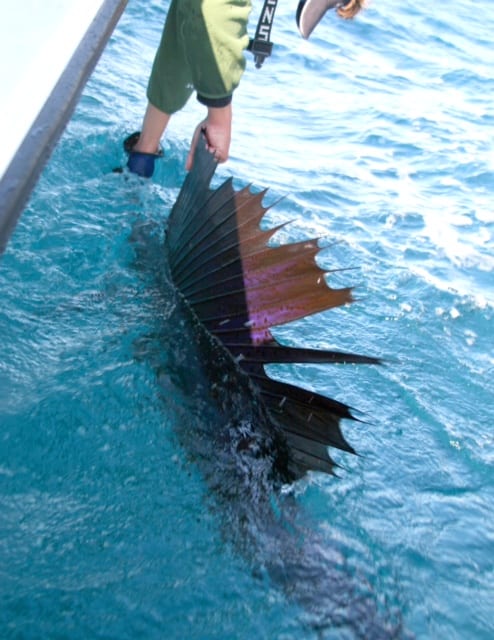by Bill Buckley, Contributing Writer

December’s cooler water temperatures bring a lot of angling opportunities to our area. Ample baitfish are available in and near the inlets and beaches, including ballyhoo and balao when chumming over shallow reefs. Shore-bound anglers can target spanish mackerel, bluefish, and jack crevelle by casting shiny spoons and Got-Cha lures from jetties, beaches, and piers. Sheepshead can be caught on live shrimp along seawalls and inshore structures. Snook can be caught at the inlets, bridges, and spillways using live baits, Flair Hawk-style jigs, and D.O.A. shrimp lures. (Note: Snook season closes December 15th.) Boaters can target spanish mackerel and bluefish in shallow waters too, but also have access to spinner sharks, bonito, wahoo, kingfish, football blackfin tunas, sailfish, and even the occasional blue or white marlin offshore.
The seas are typically rougher in the winter, often too dangerous for small boats. But, you still need to get out on the water after a hard day’s work, right? Try shrimping! It’s a lot of fun, and the catch can be eaten or used as live bait. Just about every inshore fish loves live shrimp. The best conditions for shrimping in the inlets are when the water temperature drops below 82°F, the winds are blowing strong from the east or southeast, and the tide is hard incoming at night for a couple days before and after a new or full moon (Dec. 17 and Jan. 1, respectively). Sweep the beam of a hand-held spotlight to illuminate the beady little reflective eyes of shrimp as they drift by in the current. Use a wide, long-handled dip net with small mesh to scoop them up. Boaters have the advantage of positioning where the current is flowing best, but seawall anglers can catch good numbers of shrimp as well. The daily bag limit for shrimp (heads on) in our area is 5 gallons per angler (shore-bound), or 5 gallons per vessel regardless of the number of anglers aboard. On your way back to the dock, toss a live shrimp near the fender lights at bridges or near docks with underwater lights for your chance at a nice snook to finish the night.
For anglers with larger boats that can safely handle rough seas on windy days, winter is the best time to target sailfish. By far, the best technique is kite fishing with live goggle-eyes, which does require a moderate investment in tackle, accessories, and bait. For the more budget-restricted anglers: Catch blue runners in the morning by slow trolling in the shallows near inlets and patch reefs with large Sabikis. Attach a bucktail jig at the end instead of a lead weight. Drift in 80-275ft of water with a combination of surface and mid-water live baits. A small balloon may be needed to keep your shallow baits near the surface. Wire leaders are not recommended for targeting sailfish, but if your baits are getting cut off, incorporate a short length of wire between the leader and hook to catch kingfish or wahoo that are stealing your hooks.
Sailfish typically put up a great fight, but can become victim of their own exhaustion. After a long fight, be sure to drag the sailfish slowly forward for several minutes to help it revive. Avoid damaging their internal organs by leaving them in the water. Although usually released, FWC rules do allow for an HMS-permitted angler to keep one sailfish per day over 63 inches, measured from the tip lower jaw to the fork of the tail.
Bill Buckley “Uncle Buck”
Graphic artist & offshore angler, Boca Raton, FL